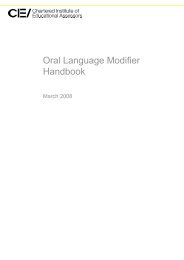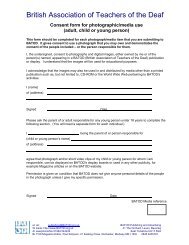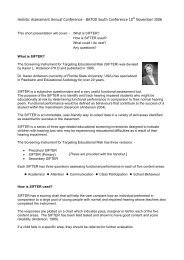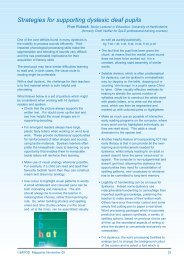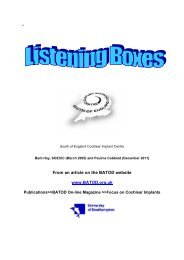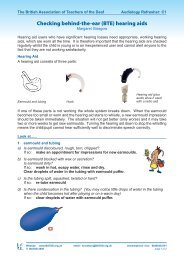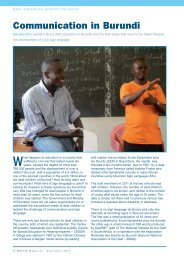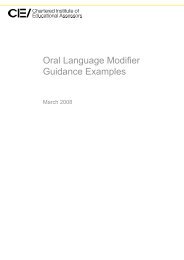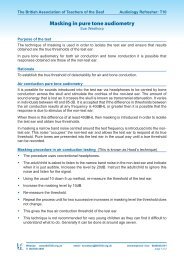o<strong>the</strong>r types have used spoken language. Special<strong>school</strong>s are now bil<strong>in</strong>gual <strong>school</strong>s <strong>for</strong> specialneeds education. When we asked parents <strong>and</strong>teachers whe<strong>the</strong>r <strong>the</strong>y felt that <strong>the</strong> <strong>school</strong>had succeeded <strong>in</strong> giv<strong>in</strong>g <strong>the</strong> pupils an equaleducation, irrespective of hear<strong>in</strong>g impairment,<strong>the</strong> parents were more doubtful than <strong>the</strong>teachers. Diagram 9 shows whe<strong>the</strong>r parents <strong>and</strong>teachers th<strong>in</strong>k that <strong>the</strong> <strong>school</strong> has succeeded <strong>in</strong>giv<strong>in</strong>g <strong>the</strong> pupils an equal education ‘to quite agreat extent or a very great extent’.The pupils’ self-confidence <strong>and</strong> ability tocooperate are essential elements of <strong>the</strong> task of <strong>the</strong><strong>school</strong>, but <strong>the</strong> <strong>school</strong>s’ success <strong>in</strong> this respectdepends on several different factors. We askedparents as well as teachers whe<strong>the</strong>r <strong>the</strong>y thoughtthat <strong>the</strong> <strong>school</strong>s had succeeded with this.The responses showed that <strong>the</strong>re is a cleardifference between how parents perceive <strong>the</strong><strong>school</strong>’s work on <strong>the</strong>se issues <strong>and</strong> <strong>the</strong> <strong>school</strong>’sown underst<strong>and</strong><strong>in</strong>g of <strong>the</strong> situation (seediagram 10). Special <strong>school</strong>’s parents <strong>and</strong>teachers have a similar picture of how <strong>the</strong> <strong>school</strong>succeeds <strong>in</strong> its task of develop<strong>in</strong>g <strong>the</strong> ability ofpupils to cooperate.A hear<strong>in</strong>g/communication factor can, of course,exist here, affect<strong>in</strong>g <strong>the</strong> possibility <strong>for</strong> <strong>the</strong> <strong>school</strong>sto succeed <strong>in</strong> develop<strong>in</strong>g <strong>the</strong> pupils’ ability tocooperate, <strong>and</strong> this can be an explanation <strong>for</strong>special <strong>school</strong>s hav<strong>in</strong>g a smaller proportionthan o<strong>the</strong>r types of <strong>school</strong>s. When we asked <strong>the</strong>teachers what it is that governs <strong>the</strong> teach<strong>in</strong>g, itseems that <strong>in</strong> compulsory <strong>school</strong> – but not <strong>in</strong><strong>school</strong>s <strong>for</strong> <strong>the</strong> hear<strong>in</strong>g <strong>impaired</strong> – it is commonthat recommendations from peripatetic teachersgovern <strong>the</strong> teach<strong>in</strong>g <strong>for</strong> 60% of <strong>the</strong> pupils. At<strong>school</strong>s <strong>for</strong> <strong>the</strong> hear<strong>in</strong>g <strong>impaired</strong> <strong>and</strong> special<strong>school</strong>, this is much less common, probably dueto <strong>the</strong> expertise exist<strong>in</strong>g at <strong>the</strong> <strong>school</strong>. Instead,<strong>the</strong> work team has a greater <strong>in</strong>fluence on <strong>the</strong>teach<strong>in</strong>g. All of <strong>the</strong> <strong>school</strong>s, however, do ofcourse have <strong>the</strong> pupil’s needs <strong>in</strong> focus whenplann<strong>in</strong>g <strong>the</strong> teach<strong>in</strong>g.We wondered whe<strong>the</strong>r any differences existedbetween <strong>the</strong> type of <strong>school</strong>s with regard to <strong>the</strong>teachers’ assessment of what is important <strong>for</strong>achiev<strong>in</strong>g goals <strong>in</strong> <strong>school</strong>. The teach<strong>in</strong>g at <strong>school</strong>s<strong>for</strong> <strong>the</strong> hear<strong>in</strong>g <strong>impaired</strong> seems to emphasiseprimarily that <strong>the</strong> pupils should present workof <strong>the</strong>ir own, carry on discussions <strong>in</strong> class, plan<strong>the</strong>ir own work <strong>and</strong> talk about books <strong>the</strong>y haveread. At special <strong>school</strong>s, unlike o<strong>the</strong>r <strong>school</strong>s, ithas been deemed <strong>in</strong> respect of a small proportionof pupils (10%) that presentation of <strong>the</strong> pupil’sown work, discussions <strong>in</strong> class, conversationsabout <strong>the</strong> pupil’s own texts <strong>and</strong> writ<strong>in</strong>g simpletexts are not particularly important, or notimportant at all, <strong>for</strong> goal <strong>fulfilment</strong>. O<strong>the</strong>rwise,<strong>the</strong> <strong>school</strong>s seem to be alike <strong>in</strong> this respect.School <strong>for</strong> pupils with learn<strong>in</strong>g disabilitiesdist<strong>in</strong>guish <strong>the</strong>mselves here as <strong>the</strong>y works <strong>in</strong>accordance with o<strong>the</strong>r goals. Accord<strong>in</strong>g to <strong>the</strong>teachers, <strong>the</strong> most important aspect here is that<strong>the</strong> pupils put <strong>for</strong>ward <strong>the</strong>ir own op<strong>in</strong>ions. Thiscorresponds well with <strong>the</strong>se <strong>school</strong>s activities <strong>and</strong>goals.F<strong>in</strong>ally, we wondered whe<strong>the</strong>r <strong>the</strong> teachers, whenaward<strong>in</strong>g grades, would disregard certa<strong>in</strong> goalsif <strong>the</strong> pupil had a permanent disability or someo<strong>the</strong>r similar, non-temporary personal condition(SFS 1994:1194; SFS 1995:401). Of <strong>the</strong> teachersof hear<strong>in</strong>g <strong>impaired</strong> pupils at compulsory <strong>school</strong>soutside <strong>the</strong> <strong>school</strong>s <strong>for</strong> <strong>the</strong> hear<strong>in</strong>g <strong>impaired</strong>,20% responded that <strong>the</strong>y would make use ofthis possibility.The proportion of teachers whodo this at special <strong>school</strong>s is <strong>the</strong> same. At <strong>school</strong>s<strong>for</strong> <strong>the</strong> hear<strong>in</strong>g <strong>impaired</strong>, on <strong>the</strong> o<strong>the</strong>r h<strong>and</strong>, asmany as 40% of <strong>the</strong> teachers say <strong>the</strong>y would usethis possibility (see diagram 11).54 <strong>Goal</strong> <strong>fulfilment</strong> <strong>in</strong> <strong>school</strong> <strong>for</strong> <strong>the</strong> <strong>deaf</strong> <strong>and</strong> hear<strong>in</strong>g <strong>impaired</strong>
Conclud<strong>in</strong>g analysisThe National Agency <strong>for</strong> Special Schools <strong>for</strong> <strong>the</strong> Deaf <strong>and</strong> Hard ofHear<strong>in</strong>g’s assessment”They have different needs <strong>and</strong> different goals <strong>in</strong> <strong>school</strong>. They have different prerequisites <strong>and</strong> receive differenttypes of support but many still do not achieve <strong>the</strong> knowledge goals.”The National Agency <strong>for</strong> Special Schools <strong>for</strong><strong>the</strong> Deaf <strong>and</strong> Hard of Hear<strong>in</strong>g has carried outthis evaluation project <strong>in</strong> consultation with <strong>the</strong>National Agency <strong>for</strong> Education. The evaluationproject was addressed to <strong>the</strong> National Agency<strong>for</strong> Special Schools <strong>for</strong> <strong>the</strong> Deaf <strong>and</strong> Hard ofHear<strong>in</strong>g <strong>in</strong> <strong>the</strong> Government approval document<strong>for</strong> <strong>the</strong> year 2006. The National Agency <strong>for</strong>Special Schools <strong>for</strong> <strong>the</strong> Deaf <strong>and</strong> Hard ofHear<strong>in</strong>g <strong>the</strong>re<strong>for</strong>e presents <strong>the</strong> clos<strong>in</strong>g analysishere.The evaluation project has revealed that, withreference to goal <strong>fulfilment</strong>, <strong>the</strong>re are proven,clear differences between special <strong>school</strong>s <strong>and</strong>o<strong>the</strong>r types of <strong>school</strong>.This project has shown that merit rat<strong>in</strong>gs aresignificantly lower <strong>in</strong> special <strong>school</strong>s than<strong>in</strong> <strong>school</strong>s <strong>for</strong> <strong>the</strong> hear<strong>in</strong>g <strong>impaired</strong> <strong>and</strong> <strong>for</strong><strong>in</strong>dividually placed pupils. The proportion ofpupils qualify<strong>in</strong>g <strong>for</strong> upper secondary <strong>school</strong> islower <strong>in</strong> special <strong>school</strong>s, while <strong>the</strong> proportionof pupils not achiev<strong>in</strong>g goals <strong>in</strong> one or moresubjects is significantly higher <strong>in</strong> this type of<strong>school</strong>. The lower grade values <strong>in</strong> special <strong>school</strong>sapply to all <strong>the</strong> qualification subjects. Pupils atspecial <strong>school</strong>s have, on average, grades <strong>in</strong> fewersubjects.The assessment also shows that <strong>the</strong> distributionof grades is greatest <strong>for</strong> pupils at special <strong>school</strong>but particularly <strong>for</strong> boys at special <strong>school</strong> <strong>and</strong> <strong>for</strong>boys born outside Sweden.The differences are especially marked with regardto <strong>the</strong> way <strong>in</strong> which <strong>the</strong> types of <strong>school</strong>s areorganised, <strong>the</strong> pupil base <strong>and</strong> <strong>the</strong> results we havepresented through us<strong>in</strong>g grades. Differencesalso occur <strong>in</strong> <strong>the</strong> way <strong>in</strong> which <strong>the</strong> goals <strong>in</strong> <strong>the</strong>curriculum are achieved.There could be many reasons <strong>for</strong> <strong>the</strong> resultsappear<strong>in</strong>g as <strong>the</strong>y do. Here, <strong>the</strong> National Agency<strong>for</strong> Special Schools <strong>for</strong> <strong>the</strong> Deaf <strong>and</strong> Hard ofHear<strong>in</strong>g highlights six explanations <strong>for</strong> <strong>the</strong>significant differences:Degree of hear<strong>in</strong>g loss <strong>and</strong> <strong>deaf</strong>ness Proportionof pupils with additional disabilities Proportionof pupils born <strong>in</strong> o<strong>the</strong>r countries Applicationof exception from goals while grad<strong>in</strong>g, due todisability Pupils who change type of <strong>school</strong>Conditions <strong>for</strong> teach<strong>in</strong>g (visual teach<strong>in</strong>g asopposed to auditory)Degree of hear<strong>in</strong>g loss <strong>and</strong> <strong>deaf</strong>nessSpecial <strong>school</strong>s admit pupils who, due to<strong>the</strong>ir hear<strong>in</strong>g loss <strong>and</strong> <strong>deaf</strong>ness, cannot go tocompulsory <strong>school</strong> <strong>and</strong> who have actively soughta bil<strong>in</strong>gual environment. When, <strong>in</strong> this project,we asked parents about <strong>the</strong>ir children’s hear<strong>in</strong>gloss <strong>and</strong> about <strong>the</strong> grounds on which <strong>the</strong>yhad chosen a <strong>school</strong>, it became apparent that<strong>the</strong> pupils’ hear<strong>in</strong>g loss <strong>and</strong> <strong>deaf</strong>ness are moreimportant as reasons <strong>for</strong> choice of <strong>school</strong> with<strong>in</strong>special <strong>school</strong> than <strong>in</strong> compulsory <strong>school</strong>. Theparents of <strong>the</strong>se children seek a <strong>school</strong> that cancreate an environment that will function from<strong>the</strong> communicative perspective. Thus <strong>the</strong>y choosea <strong>school</strong> partly on <strong>the</strong> basis of o<strong>the</strong>r criteria thano<strong>the</strong>r parent groups. For this reason, <strong>the</strong>re aremore <strong>deaf</strong> <strong>and</strong> severely hear<strong>in</strong>g <strong>impaired</strong> pupilsat special <strong>school</strong>s than at o<strong>the</strong>r types of <strong>school</strong>s.On compar<strong>in</strong>g special <strong>school</strong> with compulsory<strong>school</strong>, it is <strong>the</strong>re<strong>for</strong>e important to rememberthat <strong>the</strong> groups are not 100% comparable.<strong>Goal</strong> <strong>fulfilment</strong> <strong>in</strong> <strong>school</strong> <strong>for</strong> <strong>the</strong> <strong>deaf</strong> <strong>and</strong> hear<strong>in</strong>g <strong>impaired</strong>55
- Page 2 and 3:
This is a translation of main parts
- Page 4 and 5: Goal fulfilment in school for the d
- Page 6 and 7: Table of Contents, contd.Concluding
- Page 8 and 9: Abbreviations and terms 1SPMSVSITTh
- Page 10 and 11: The Swedish Compulsory SchoolCompul
- Page 12 and 13: of teaching in different subjects,
- Page 14 and 15: The SPM has in the report “Pupils
- Page 16 and 17: In addition to the variation in typ
- Page 18 and 19: Attitudes to sign language, long re
- Page 20 and 21: Compulsory school for pupils withle
- Page 22 and 23: In 2007, the SPM reported to the Mi
- Page 24 and 25: impaired pupils’ reading levels i
- Page 26 and 27: Method and implementationMethodPrev
- Page 28 and 29: Figure 1. Flow chart of the collect
- Page 30 and 31: 3,503,002,50Prevalence2,001,501,000
- Page 32 and 33: Table 7. Distribution of responses
- Page 34 and 35: ResultsTypes of schoolsSchools in S
- Page 36 and 37: 100908070Procent60504030Mild hearin
- Page 38 and 39: the 16 best grades in a pupil’s l
- Page 40 and 41: Table 10. The proportion (%) of pup
- Page 42 and 43: Table 14. Proportion (%) of boys aw
- Page 44 and 45: EnglishThe goals for the learning E
- Page 46 and 47: Table 22. Proportion (%) of pupils
- Page 48 and 49: It is also important to note that t
- Page 50 and 51: Table 26. Proportion (%) in respect
- Page 52 and 53: TeachersParents91878176 76726564Per
- Page 56 and 57: On the basis of the assessment resu
- Page 58 and 59: For instance, it can be mentioned t
- Page 60 and 61: Special Schools for the Deaf and Ha
- Page 62 and 63: LiteratureUnpublished sourcesConiav
- Page 64 and 65: Specialskolemyndigheten. . Hämtad
- Page 66 and 67: se>. Välj rubrik “Publikationer
- Page 68 and 69: Appendice I1II. Compulsory School (
- Page 70 and 71: Appendice IVIV. Special school for
- Page 72: The National Agency for Special Nee



